Satas D., Tracton A.A. (ed.). Coatings Technology Handbook
Подождите немного. Документ загружается.

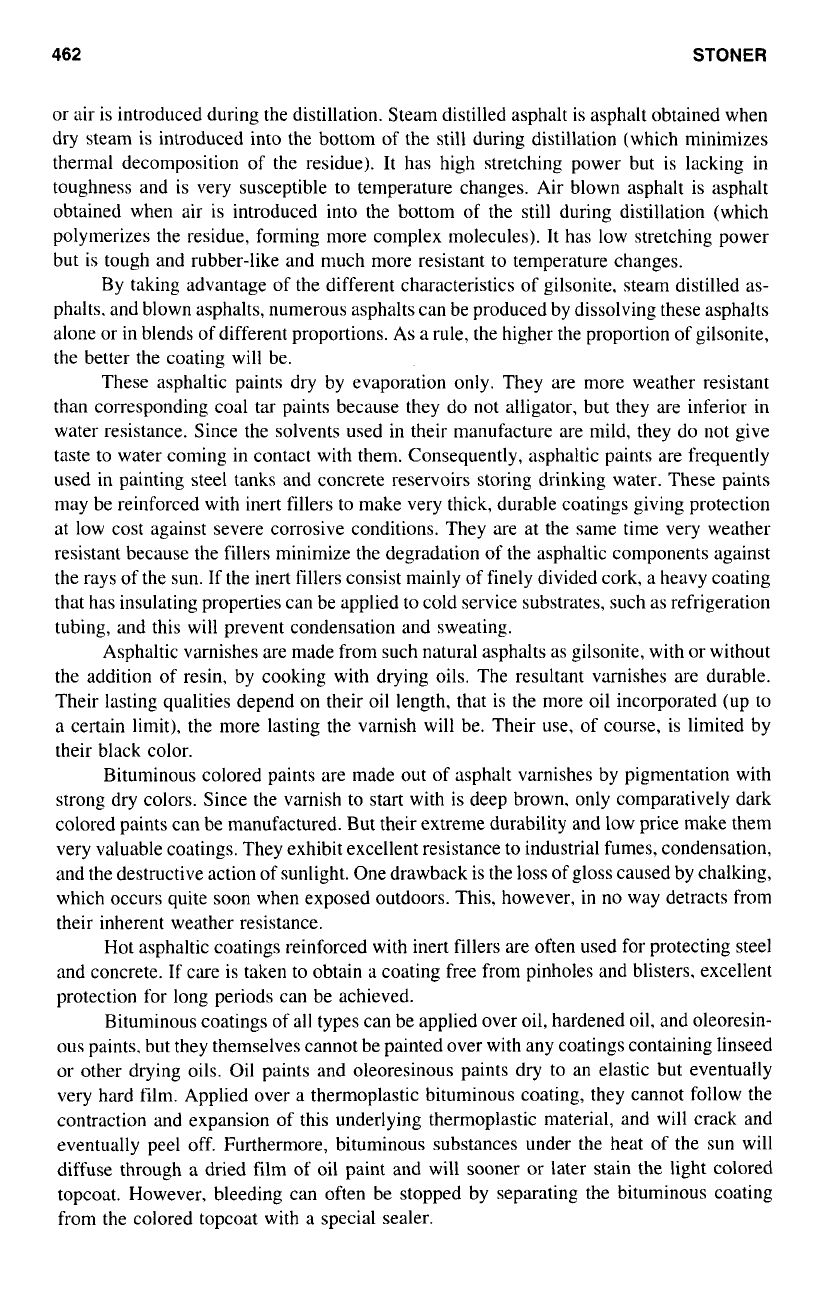
462
STONER
or air is introduced during the distillation. Steam distilled asphalt is asphalt obtained when
dry steam is introduced into the bottom of the still during distillation (which minimizes
thermal decomposition
of
the residue). It has high stretching power but is lacking in
toughness and is very susceptible to temperature changes. Air blown asphalt is asphalt
obtained when air is introduced into the bottom of the still during distillation (which
polymerizes the residue, forming more complex molecules). It has low stretching power
but is tough and rubber-like and much more resistant to temperature changes.
By taking advantage of the different characteristics of gilsonite, steam distilled as-
phalts. and blown asphalts, numerous asphalts can be produced by dissolving these asphalts
alone or in blends of different proportions. As a rule, the higher the proportion of gilsonite,
the better the coating will be.
These asphaltic paints dry by evaporation only. They are more weather resistant
than corresponding coal tar paints because they do
not
alligator, but they are inferior in
water resistance. Since the solvents used in their manufacture are mild, they do not give
taste to water coming in contact with them. Consequently, asphaltic paints are frequently
used in painting steel tanks and concrete reservoirs storing drinking water. These paints
may be reinforced with inert fillers to make very thick, durable coatings giving protection
at low cost against severe corrosive conditions. They are at the same time very weather
resistant because the fillers minimize the degradation
of
the asphaltic components against
the rays
of
the sun. If the inert fillers consist mainly of finely divided cork, a heavy coating
that has insulating properties can be applied
to
cold service substrates, such as refrigeration
tubing, and this will prevent condensation and sweating.
Asphaltic varnishes are made from such natural asphalts as gilsonite, with or without
the addition
of
resin, by cooking with drying oils. The resultant varnishes are durable.
Their lasting qualities depend on their
oil
length, that is the more oil incorporated (up to
a certain limit), the more lasting the varnish will be. Their use, of course, is limited by
their black color.
Bituminous colored paints are made out of asphalt varnishes by pigmentation with
strong dry colors. Since the varnish to start with is deep brown. only comparatively dark
colored paints can be manufactured. But their extreme durability and low price make them
very valuable coatings. They exhibit excellent resistance to industrial fumes, condensation,
and the destructive action of sunlight. One drawback is the loss of gloss caused by chalking,
which occurs quite soon when exposed outdoors. This, however, in no way detracts from
their inherent weather resistance.
Hot asphaltic coatings reinforced with inert fillers are often used for protecting steel
and concrete. If care is taken to obtain a coating free from pinholes and blisters, excellent
protection for long periods can be achieved.
Bituminous coatings of all types can be applied over oil, hardened oil, and oleoresin-
ous paints. but they themselves cannot be painted over with any coatings containing linseed
or other drying oils. Oil paints and oleoresinous paints dry to an elastic but eventually
very hard film. Applied over
a
thermoplastic bituminous coating, they cannot follow the
contraction and expansion of this underlying thermoplastic material, and will crack and
eventually peel off. Furthermore, bituminous substances under the heat of the sun will
diffuse through
a
dried film
of
oil paint and will sooner or later stain the light colored
topcoat. However, bleeding can often be stopped by separating the bituminous coating
from the colored topcoat with a special sealer.
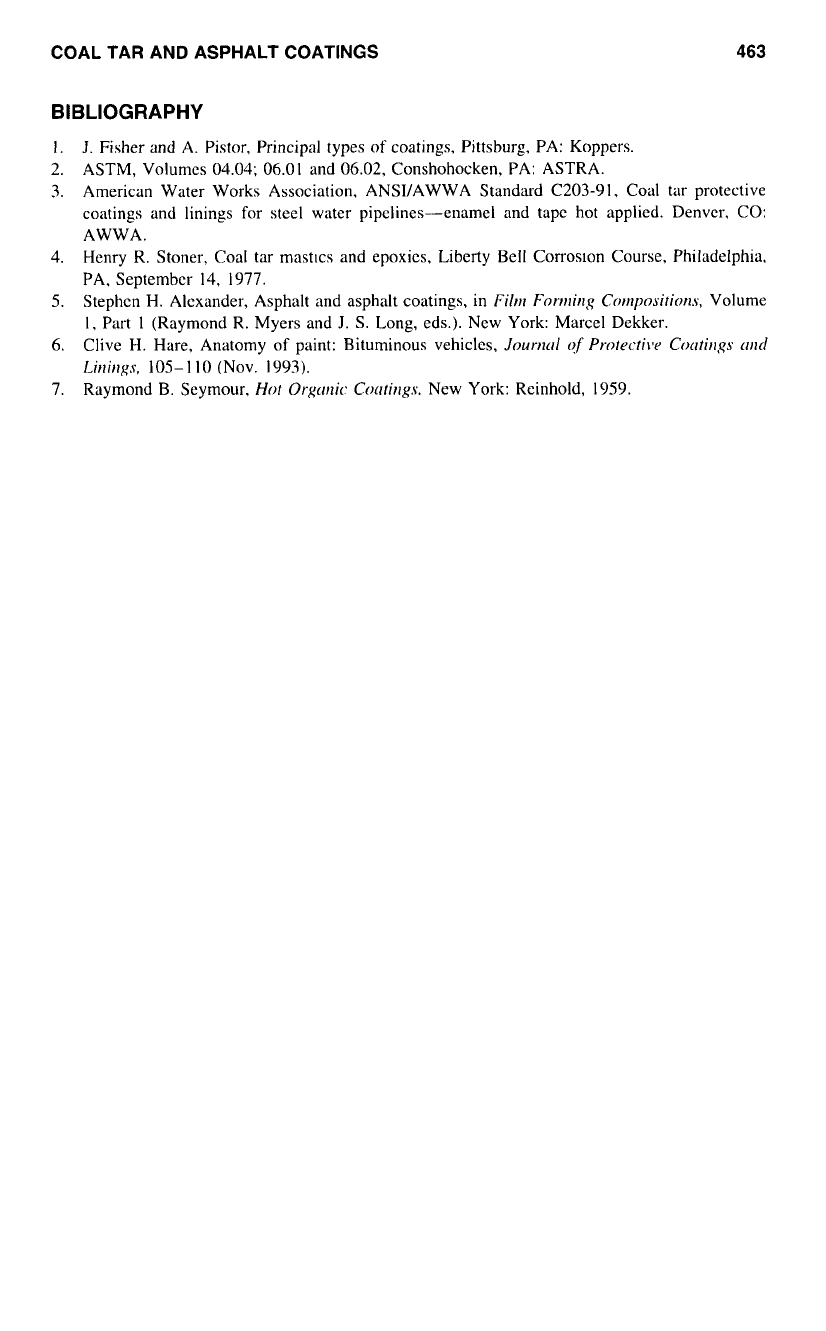
COAL TAR AND ASPHALT COATINGS
463
BIBLIOGRAPHY
I.
J.
Fisher and A. Pistor, Principal types of coatings, Pittsburg, PA: Koppers.
2. ASTM, Volumes 04.04;
06.01
and
06.02,
Conshohocken, PA: ASTRA.
3.
American Water Works Association, ANSVAWWA Standard C203-91, Coal tar protective
coatings and linings for steel water pipelines-enamel and tape hot applied. Denver.
CO:
AWWA.
4.
Henry R. Stoner,
Coal
tar mastlcs and epoxies, Liberty Bell Conoslon Course, Philadelphia,
5.
Stephen
H.
Alexander, Asphalt and asphalt coatings, in
Filrr~
Forming
Cornposirions,
Volume
6.
Clive H. Hare, Anatomy of paint: Bituminous vehicles,
Jounztrl
of
Pro/rcri\je
Cocrtirlgs
trrld
7.
Raymond
B.
Seymour,
Hot
Orgarlic
Cocr/irlg.s.
New York: Reinhold, 1959.
PA. September 14, 1977.
I,
Part
1
(Raymond R. Myers and
J.
S.
Long, eds.). New York: Marcel Dekker.
Lirlirlgs,
105-1
IO
(Nov. 1993).
This Page Intentionally Left Blank
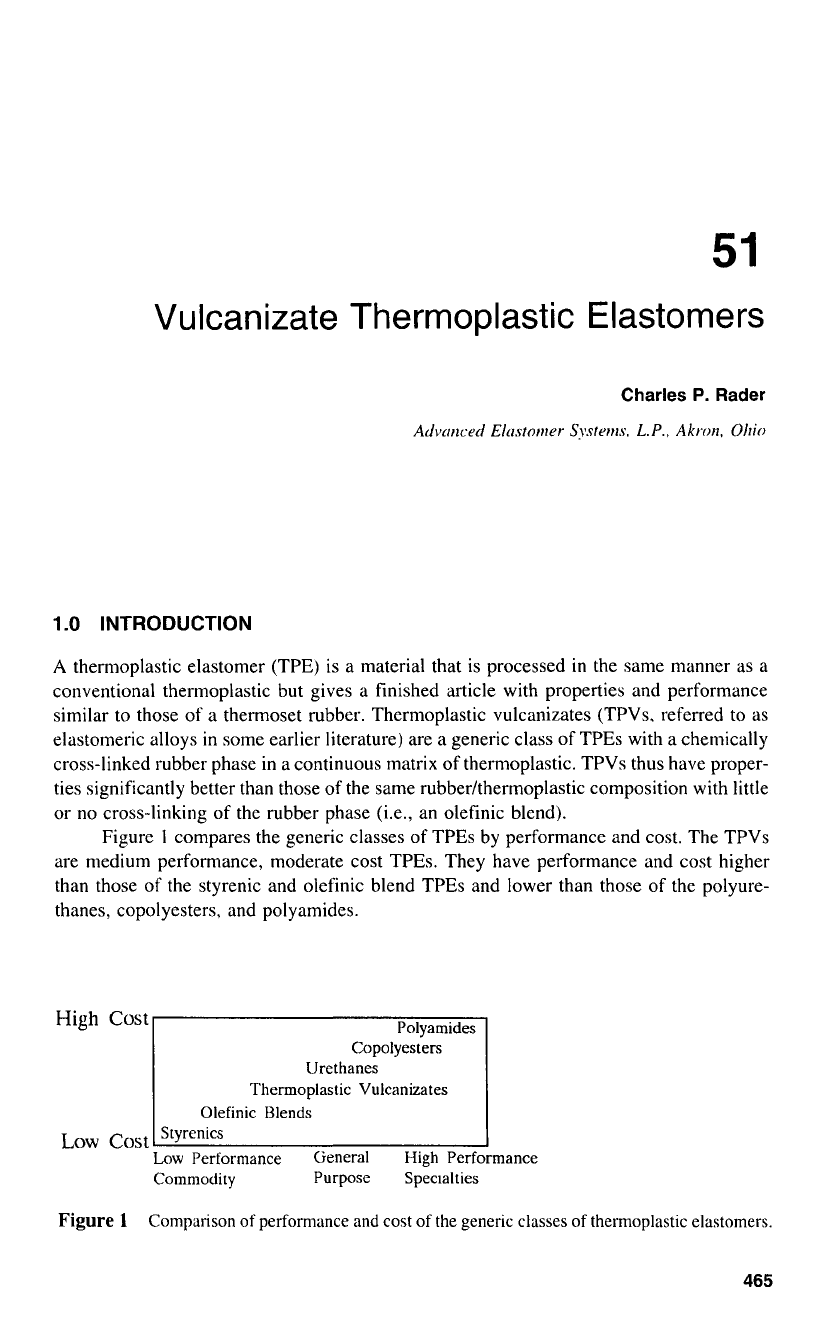
51
Vulcanizate Thermoplastic Elastomers
Charles
P.
Rader
Advrrrzcerl
Eltrstorrzer
Sysfenw.
L.P..
Akron.
Ohio
1
.O
INTRODUCTION
A
thermoplastic elastomer (TPE) is
a
material that is processed
in
the same manner as
a
conventional thermoplastic but gives
a
finished article with properties and performance
similar to those
of
a thermoset rubber. Thermoplastic vulcanizates (TPVs. referred to
as
elastomeric alloys
in
some earlier literature) are
a
generic class of TPEs with
a
chemically
cross-linked rubber phase in
a
continuous matrix
of
thermoplastic. TPVs thus have proper-
ties significantly better than those
of
the same rubber/thermoplastic composition with little
or no cross-linking of the rubber phase (i.e., an olefinic blend).
Figure
1
compares the generic classes of TPEs by performance and cost. The TPVs
are medium performance, moderate cost TPEs. They have performance and cost higher
than those
of
the styrenic and olefinic blend TPEs and lower than those of the polyure-
thanes, copolyesters, and polyamides.
High
Cost
Low
Cost
L
L
Polyamides
Copolyesters
Thermoplastic Vulcanizates
Urethanes
Olefinic Blends
Stvrenics
-1
mw
Performance General High Performance
Commodity Purpose Speclalties
Figure
1
Comparison
of
performance and cost
of
the generic classes
of
thermoplastic elastomers.
465

466
RADER
2.0
PROPERTIES
The cross-linking of a TPV rubber phase gives improvement to a number of properties
of
a specific rubber/thermoplastic composition, such as EPDM rubber/polypropylene (PP).
These property improvements include tensile strength, tensile and compression set resis-
tance, stress relaxation. fluid resistance, and retention of properties at elevated temperature.
These improvements qualify TPVs for many uses where a simple rubber/polyolefin blend
would be inadequate.
Key parameters for the premium performance of a TPV are
(
1
)
the degree of cross-
linking
of
the rubber phase,
(2)
the degree of dispersion of the rubber phase
in
the thermo-
plastic phase. and
(3)
the thermodynamic compatibility
of
the polymers present. TPV
performance is known to be improved by greater cross-linking, dispersion, and polymer
compatibility. TPVs with high polymer compatibility have no need for a compatibilizer;
those with low compatibility (e.g., NBR rubber/PP) will need one to stabilize the intermin-
gling
of
the rubber and thermoplastic chains. The mutual compatibility of the rubber and
thermoplastic polymers will increase as the difference
in
their solubility parameters
(i.e.,
cohesive energy density) decreases.
The hardness
of
TPVs ranges from
35
Shore
A
up to
50
Shore D. EPDM/PP TPVs
are generally suitable for use
in
air from
-
60°C to
135"C,
and those from nitrile rubber/
PP have a range
in
air from
-40°C
to
125°C.
The specific gravity
of
these materials is
in the
0.9
to
1.0
range, which is
15
to
40%
lower than that of most thermoset rubber
stocks. Though of little consequence in most service requirements, the ultimate tensile
strength of a TPV is generally lower than that
of
a thermoset rubber
of
the same hardness.
Very few rubber articles are used at an elongation anywhere close to their ultimate limit.
In
compression and tension set performance, TPVs are competitive with thermoset
rubbers, being the closest approach of a TPE
to
true rubber performance. Further, their
fatigue resistance is truly outstanding. It is highly unusual for a specific rubber composition
to
give good performance in both compression set and fatigue.
EPDM-based TPVs have good resistance
to
a broad spectrum of fluid media. They
are highly resistant to water, aqueous solutions (including acids and bases), and polar
organic fluids. In nonpolar fluids they retain their physical properties well but can swell
quite significantly. The NBR/PP TPVs have lower swell in nonpolar, hydrocarbon media
and merit consideration for service
in
such environments. These TPVs, however, should
not be used in media that are highly acidic or basic.
3.0
PROCESSING
TPVs enable one
to
exploit the many processing advantages
of
a TPE. TPVs are fully
compounded and simple to process, with short molding cycles. Their processing consumes
little energy and permits ready recycling
of
scrap. Quality control is both improved and
more economical than with thermoset rubber. TPVs can be fabricated by processing meth-
ods (i.e.. blow molding. heat welding, and thermoforming) not suitable for thermoset
rubber.
Thermoplastic fabricating equipment should be used in TPV processing. Thermoset
rubber fabricating equipment is generally unsuitable for TPVs and other TPEs as well.
Before processing, most TPVs should be dried. Molten TPVs should be processed
in
the
180
to
220°C
range under conditions
of
high shear, since their flow properties are highly
non-Newtonian and thus shear sensitive. Injection molding, the most common method
of
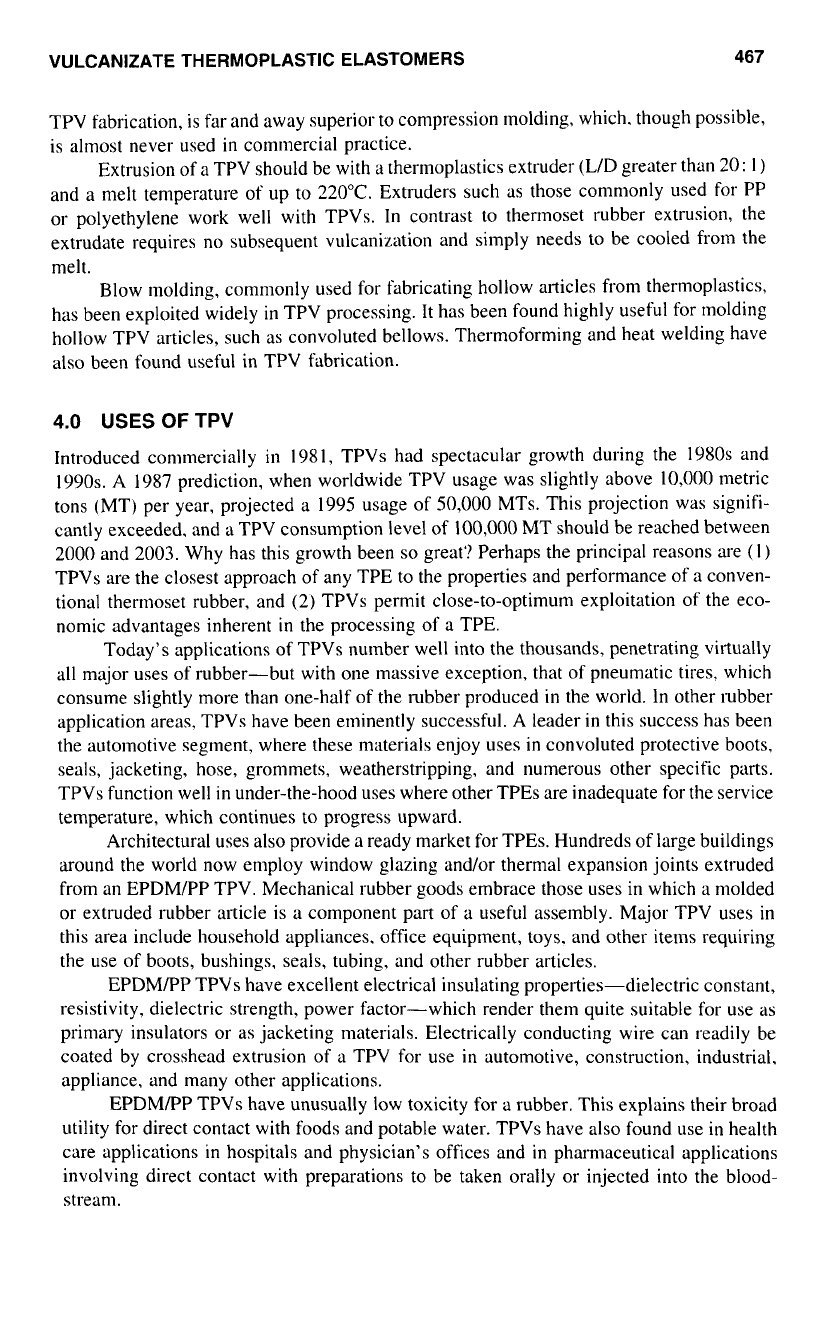
4.0
USES
OF
TPV
Introduced commercially
in
1981, TPVs had spectacular growth during the
1%0s
and
1990~.
A
1987 prediction, when worldwide TPV usage was slightly above
10,000
metric
tons (MT) per year. projected a 1995 usage of
50,000
MTs. This projection was signifi-
cantly exceeded. and a TPV consumption level of
100,000
MT should be reached between
2000
and
2003.
Why has this growth been
so
great? Perhaps the principal reasons are (1
)
TPVs are the closest approach of any TPE
to
the properties and performance of a conven-
tional thermoset rubber, and
(2)
TPVs permit close-to-optimum exploitation of the eco-
nomic advantages inherent
in
the processing of a TPE.
Today’s applications of TPVs number well into the thousands, penetrating virtually
all major uses
of
rubber-but with one massive exception, that of pneumatic tires, which
consume slightly more than one-half of the rubber produced in the world. In other rubber
application areas, TPVs have been eminently successful.
A
leader
in
this success has been
the automotive segment, where these materials enjoy uses
in
convoluted protective boots,
seals, jacketing, hose, grommets, weatherstripping, and numerous other specific parts.
TPVs function well
in
under-the-hood uses where other TPEs are inadequate for the service
temperature, which continues to progress upward.
Architectural uses
also
provide a ready market for TPEs. Hundreds of large buildings
around the world now employ window glazing and/or thermal expansion joints extruded
from an EPDM/PP TPV. Mechanical rubber goods embrace those uses in which a molded
or extruded rubber article is a component part
of
a useful assembly. Major TPV uses
in
this area include household appliances. office equipment, toys. and other items requiring
the use of boots, bushings, seals, tubing, and other rubber articles.
EPDMPP TPVs have excellent electrical insulating properties-dielectric constant,
resistivity. dielectric strength, power factor-which render them quite suitable for use as
primary insulators or as jacketing materials. Electrically conducting wire can readily be
coated by crosshead extrusion of
a
TPV for use
in
automotive, construction, industrial,
appliance. and many other applications.
EPDMPP TPVs have unusually low toxicity for a rubber. This explains their broad
utility for direct contact with foods and potable water. TPVs have also found use in health
care applications in hospitals and physician’s offices and in pharmaceutical applications
involving direct contact with preparations to be taken orally or injected into the blood-
stream.
This Page Intentionally Left Blank
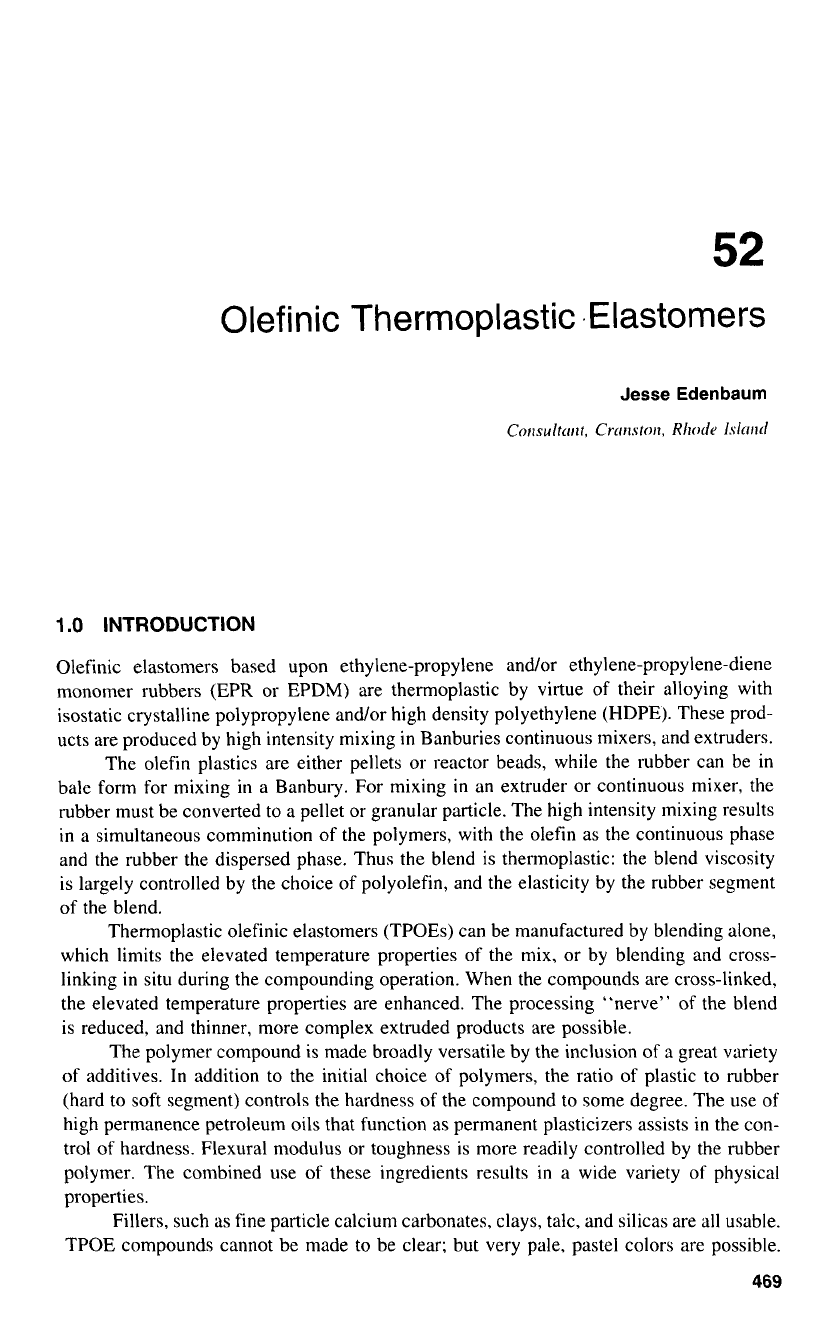
52
Olefinic Thermoplastic ,Elastomers
Jesse
Edenbaum
Cor~sulttrr~t,
Crmston,
Rhode
Islor~d
1
.O
INTRODUCTION
Olefinic elastomers based upon ethylene-propylene and/or ethylene-propylene-diene
monomer rubbers (EPR or EPDM) are thermoplastic by virtue of their alloying with
isostatic crystalline polypropylene and/or high density polyethylene (HDPE). These prod-
ucts are produced by high intensity mixing
in
Banburies continuous mixers, and extruders.
The olefin plastics are either pellets
or
reactor beads, while the rubber can be in
bale form for mixing
in
a Banbury.
For
mixing
in
an extruder or continuous mixer, the
rubber must be converted to a pellet
or
granular particle. The high intensity mixing results
in a simultaneous comminution
of
the polymers, with the olefin as the continuous phase
and the rubber the dispersed phase. Thus
the
blend is thermoplastic: the blend viscosity
is largely controlled by the choice of polyolefin, and the elasticity by the rubber segment
of the blend.
Thermoplastic olefinic elastomers (TPOEs) can be manufactured by blending alone,
which limits the elevated temperature properties of the mix, or by blending and cross-
linking in situ during the compounding operation. When the compounds are cross-linked,
the elevated temperature properties are enhanced. The processing “nerve”
of
the blend
is reduced, and thinner, more complex extruded products are possible.
The polymer compound is made broadly versatile by the inclusion
of
B
great variety
of additives. In addition to the initial choice
of
polymers, the ratio
of
plastic to rubber
(hard to soft segment) controls the hardness
of
the compound to some degree. The use of
high permanence petroleum oils that function as permanent plasticizers assists in the con-
trol
of
hardness. Flexural modulus or toughness is more readily controlled by the rubber
polymer. The combined use
of
these ingredients results
in
a wide variety of physical
properties.
Fillers, such
as
fine particle calcium carbonates, clays, talc, and silicas are all usable.
TPOE
compounds cannot be made to be clear; but very pale, pastel colors are possible.
469
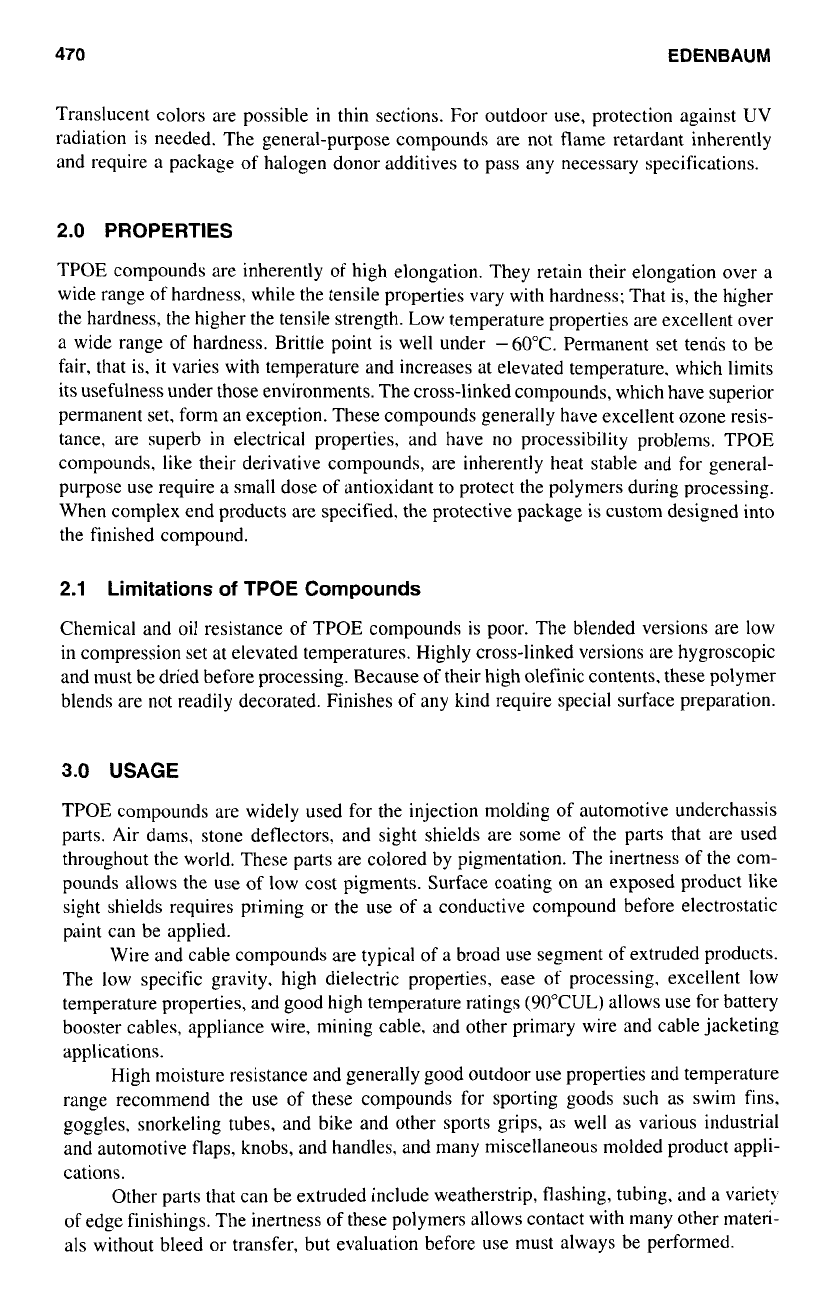
470
EDENBAUM
Translucent colors are possible
in
thin sections. For outdoor use, protection against
UV
radiation is needed. The general-purpose compounds are not flame retardant inherently
and require a package of halogen donor additives to pass any necessary specifications.
2.0
PROPERTIES
TPOE compounds are inherently of high elongation. They retain their elongation over a
wide range
of
hardness, while the tensile properties vary with hardness; That is, the higher
the hardness, the higher the tensile strength. Low temperature properties are excellent over
a wide range
of
hardness. Brittle point is well under -60°C. Permanent set tends to be
fair, that is.
it
varies with temperature and increases at elevated temperature. which limits
its usefulness under those environments. The cross-linked compounds, which have superior
permanent set, form an exception. These compounds generally have excellent ozone resis-
tance, are superb
in
electrical properties, and have no processibility problems. TPOE
compounds, like their derivative compounds, are inherently heat stable and for general-
purpose use require a small dose of antioxidant to protect the polymers during processing.
When complex end products are specified. the protective package is custom designed into
the finished compound.
2.1
Limitations
of
TPOE Compounds
Chemical and oil resistance of TPOE compounds is poor. The blended versions are low
in compression set at elevated temperatures. Highly cross-linked versions are hygroscopic
and must be dried before processing. Because of their high olefinic contents. these polymer
blends are not readily decorated. Finishes
of
any kind require special surface preparation.
3.0
USAGE
TPOE compounds are widely used for the injection molding of automotive underchassis
parts. Air dams, stone deflectors. and sight shields are some of the parts that are used
throughout the world. These parts are colored by pigmentation. The inertness of the com-
pounds allows the use of low cost pigments. Surface coating on an exposed product like
sight shields requires priming or the use of a conductive compound before electrostatic
paint can be applied.
Wire and cable compounds are typical of a broad use segment
of
extruded products.
The low specific gravity, high dielectric properties, ease of processing. excellent low
temperature properties, and good high temperature ratings (90"CUL) allows use for battery
booster cables, appliance wire, mining cable, and other primary wire and cable jacketing
applications.
High moisture resistance and generally good outdoor use properties and temperature
range recommend the use of these compounds for sporting goods such as swim fins.
goggles, snorkeling tubes, and bike and other sports grips,
as
well as various industrial
and automotive flaps, knobs, and handles, and many miscellaneous molded product appli-
cations.
Other parts that can be extruded include weatherstrip, flashing, tubing, and a variety
of edge finishings. The inertness
of
these polymers allows contact with many other materi-
als without bleed or transfer, but evaluation before use must always be performed.
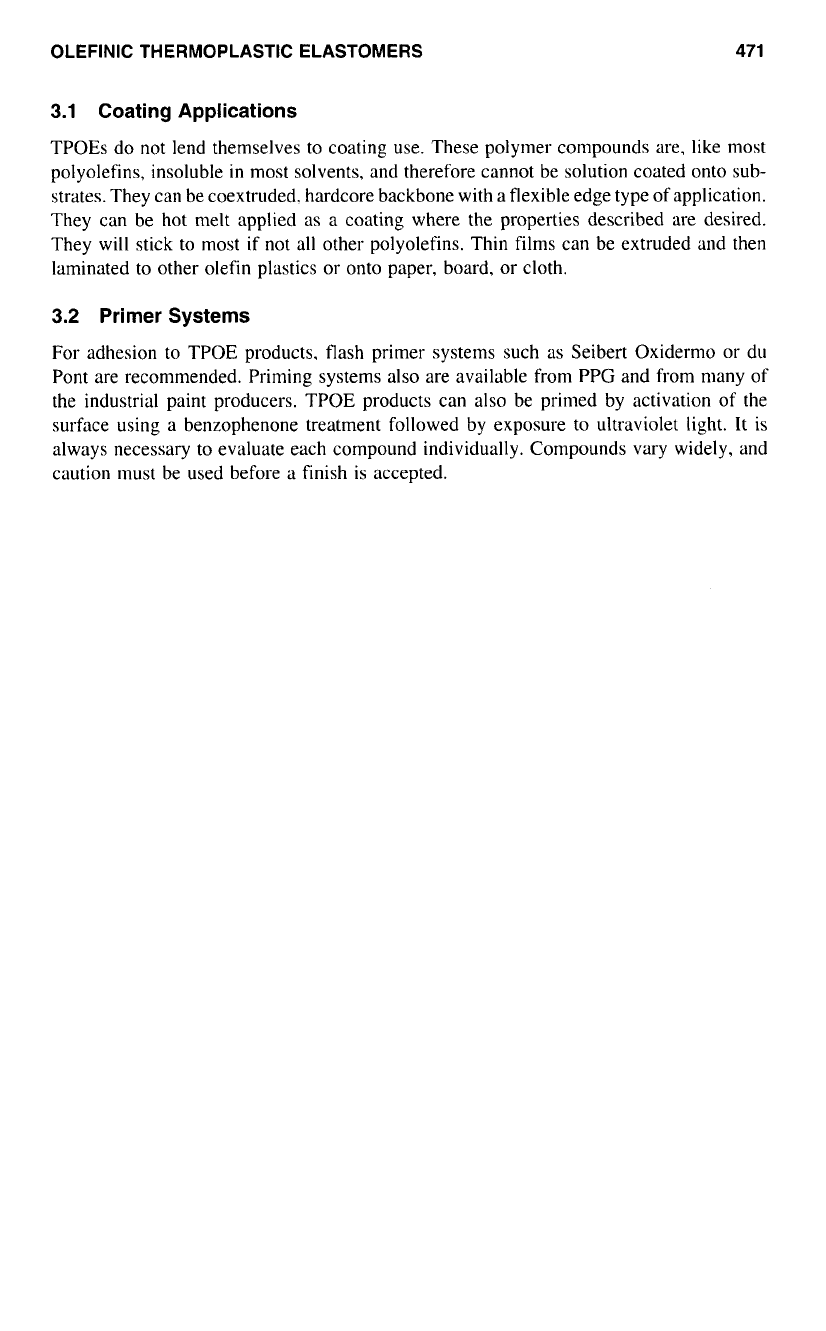
OLEFINIC THERMOPLASTIC ELASTOMERS
471
3.1
Coating Applications
TPOEs do not lend themselves to coating use. These polymer compounds are, like most
polyolefins, insoluble
in
most solvents, and therefore cannot be solution coated onto sub-
strates. They can be coextruded. hardcore backbone with a flexible edge type of application.
They can be hot melt applied as a coating where the properties described are desired.
They will stick to most
if
not
all
other polyolefins. Thin films can be extruded and then
laminated
to
other olefin plastics or onto paper, board, or cloth.
3.2
Primer Systems
For adhesion to TPOE products. flash primer systems such as Seibert Oxidernlo or du
Pont are recommended. Priming systems also are available from PPG and from many of
the industrial paint producers. TPOE products can also be primed by activation of the
surface using a benzophenone treatment followed by exposure to ultraviolet light. It is
always necessary
to
evaluate each compound individually. Compounds vary widely, and
caution must be used before a finish is accepted.
